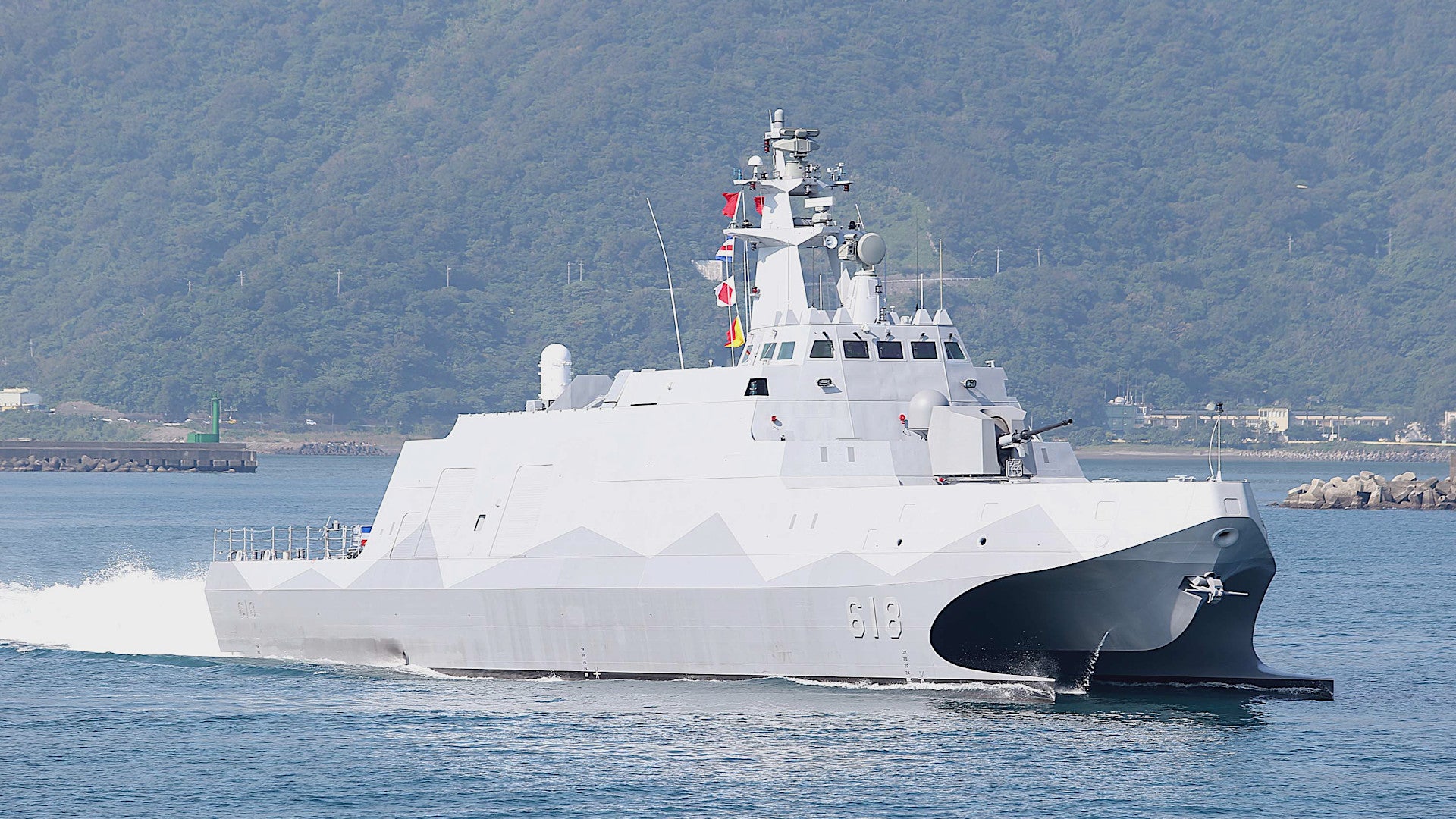Taiwan says it has started construction of a trio of stealthy missile corvettes with what appear to be racks for naval mines on the stern, as well as four dedicated minelayers. Naval mining could be an extremely important tool against China’s People’s Liberation Army Navy, especially in the narrow confines of the Taiwan Strait, during any future crisis. The Taiwanese announcement comes amid a recent spike in tensions with authorities on the mainland, who continue to warn they could invade the island if it seeks to declare independence.
Taiwanese President Tsai Ing Wen revealed the new details about the country’s naval shipbuilding efforts during a visit to one of Lung Teh Shipbuilding’s shipyard on May 24, 2019. The country’s Navy is set to receive the three Min Chiang-class corvettes in 2025. The first of the four of the Gan Chiang-class minelayers is supposed to have arrived four years before then.
The Min Chiang-class is a revision of the earlier Tou Chiang-class. Both are named after upper tributaries of the Yangtze River on the mainland. Lung Teh delivered the first Tou Chiang, effectively a prototype, in 2014.
In May 2018, Taiwanese Minister of National Defense Yen De-fa had announced that Taiwan would get a total of eight Tou Chiangs by 2025, three of which would be focused on the air defense role, while the other five would be optimized for anti-surface warfare.
It is unclear if this is still the plan, given that Tsai only spoke of the construction of the first three ships. In addition, the design Lung Teh showed off at the event does not appear to have an emphasis on air defense.
Based on the available concept art, the Min Chiangs will retain the core of the Tou Chiang’s catamaran design and stealthy superstructure. The ships will also still have anti-ship missile launchers in the central superstructure, a 76mm rapid-fire gun in a turret on the bow, and a Phalanx Close-In Weapon System (CIWS) toward the stern.
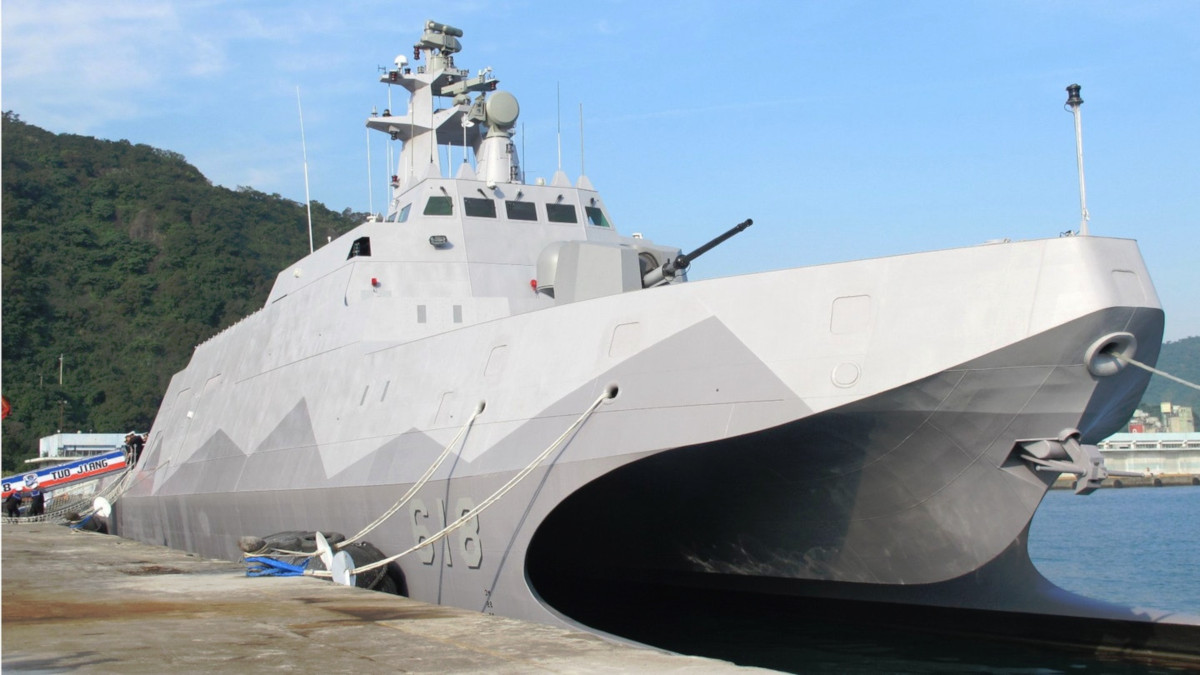
But the revised configuration ship replaces the rear helicopter pad on the original corvette with what appear to be four racks to send naval mines rolling off the back of the ship. Depending on the exact nature of the system, it might be possible to readily fit these rack onto the flight deck of the existing Tou Chiang and other future configurations based on that design.
At present, the Taiwanese Navy has no dedicated mine-laying ships. Various vessels, including its larger amphibious landing craft, do have a secondary mine-laying role. Existing mine options include bottom-lying mines, which are better suited to shallow water areas, and so-called Encapsulated Torpedo, or CAPTOR, types. The latter is, as the name implies, a torpedo inside a self-contained launch tube that has various sensors to detect ship or submarine passing by, after which it would release the weapon. You can read more about both of these general classes of mines here.
Taiwan’s government-operated National Chung Shan Institute for Science and Technology is also working on new shallow- and deep-water mines, which it hopes to have ready for service by 2021, which would coincide with the arrival of the first of the smaller Gan Chiang minelayers. There are also plans for some form of new “self-propelled” mine, which could be an improved CAPTOR type.
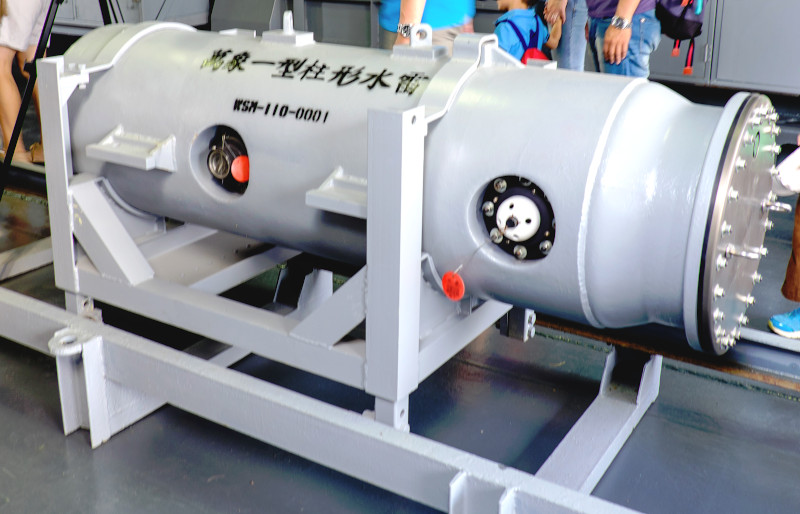
The previously announced air defense configuration was supposed to take this space and install a four-cell vertical launch system array. Each cell would contain quad-packed Tien Chien IIN, or Sky Sword IIN, medium-range surface-to-air missiles, for a total of 16 missiles, according to the earlier reports.
It is possible that the artwork is actually of the anti-surface warfare variant, but the only details about that configuration in the past were that it would be able to carry 16 Hsiung Feng II or III – Brave Wind II and III – anti-ship missiles. There was no mention of mines in either case.
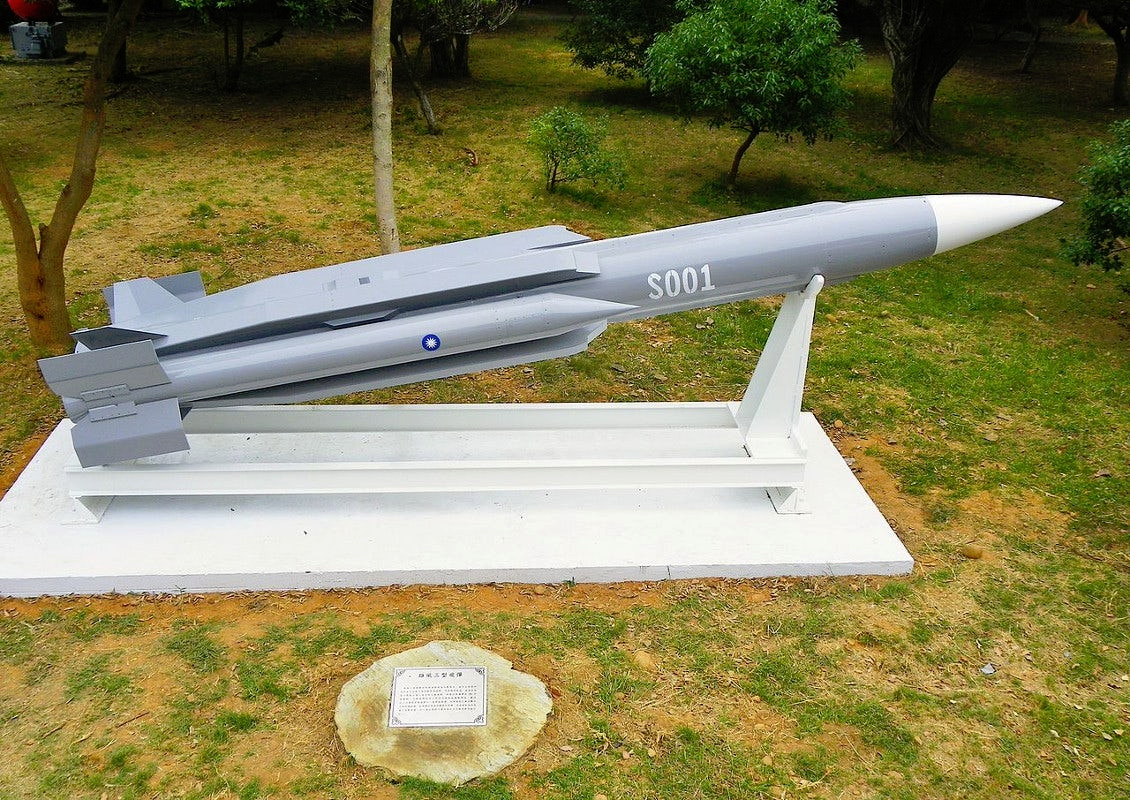
Combined with the announcement about the construction of the smaller Gan Chiang minelayers, also named after a river in China, this would all seem to point to shift in priority, at least in part, to expanding the Taiwanese Navy’s mining capabilities in the near term. Naval mining was an important component of Taiwan’s Overall Defense Concept, which it rolled out in 2017. This makes good sense in many ways, given its proximity to the mainland.
The Taiwan Strait is only around 110 miles wide and the ability to rapidly fill it with naval mines could wreak havoc on the People’s Liberation Army Navy’s (PLAN) ability to operate there, slowing them down and making them vulnerable to counterattack. Naval mines also generally have an outsized impact relative to their cost given that clearing them is a complex and dangerous process that requires significant time and resources.
The Chinese have also vastly expanded their capabilities to launch attacks on the island from any direction in the past two decades. Naval mines could help to channel those forces into a more limited number of areas, making it easier for Taiwan’s notably smaller military to best focus its resources.
Taiwanese officials have described the Tou Chiang design in the past as being a key “asymmetric” weapon. The corvettes, in general, offer a way to reduce the strain on larger warships during an actual conflict, as well as to provide additional escorts for those surface actions groups that are cheaper to build and operate.

Whatever the final mix of missile corvettes looks like in the end, that announcement coincides with a surge in tensions between Taiwan and China in recent months, which has also drawn in Taiwan’s principal ally, the United States. Just on May 22, 2019, the U.S. Navy sent two unspecified ships through the Taiwan Strait, one of a number of such transits this year already, which are seen as a show of force in support of Taiwan. The U.S. and Chinese governments are themselves locked in an increasingly serious trade war and the countries are at odds over a host of other issues, including Beijing’s territorial claims in the South China Sea.
The present state of affairs has only underscored the limitations of Taiwan’s aging military, as a whole. The country is in the process of upgrading its F-16 Viper fighter jet fleet and is now looking to acquire more modern main battle tanks, among a host of other initiatives.
When it comes to modernizing the country’s Navy, the announcement about the corvette and minelayer construction programs came just weeks after President Tsai presided over a ground-breaking ceremony for an all-new shipyard to produce a new class of indigenous diesel-electric submarines. The Taiwanese Navy has just four submarines at present, two of which are World War II-era boats the country received from the United States in the 1970s that are now relegated to training duties.
A model of the proposed new domestic design shows clear influences from the Dutch Zwaardvis-class. Taiwan’s existing pair of Hai Lung-class submarines are derived from this design, as well. There are limited details about the planned features for Taiwan’s new boats, such as whether they will include advanced Air Independent Propulsion (AIP) systems, which would drastically increase the time it can stay submerged.
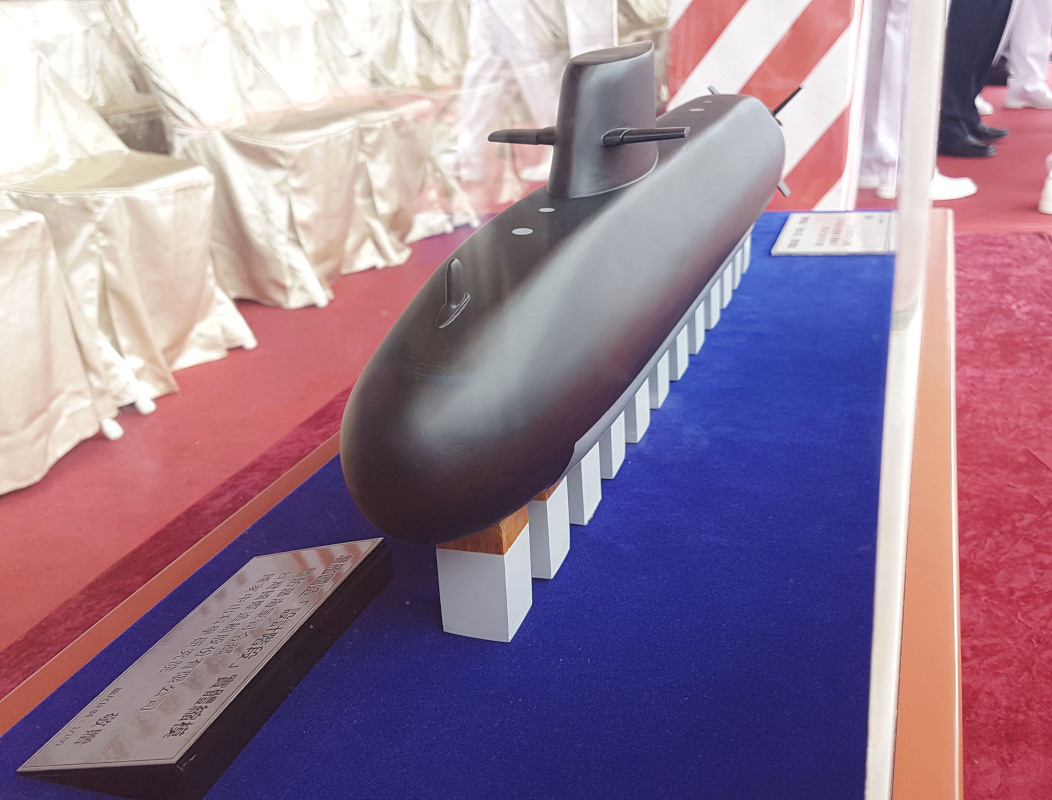
But questions remain about whether Taiwan has the resources to actually pursue all of these major military modernization programs, especially with regards to its Navy. The country’ submarine production schedule is particularly aggressive, with the goal of having the shipyard, which is just now itself under construction, deliver the first of eight new boats by 2024.
Cost considerations could certainly help explain the shift in focus toward naval mining. Taiwan would hardly be the first small Navy to go this route in order to present credible obstacles against larger potential opponents.
Still, a focus on asymmetric capabilities notwithstanding, Taiwan simply does not have the industrial capacity to match that of mainland China. If Lung Teh does end up building all eight new corvettes based on the Tou Chiang design by 2025, it will only be building one or two of these small ships each year, while the Chinese churn out significant numbers of submarines and major surface combatants, including multiple examples of the new advanced Type 055 destroyer. That’s to say nothing of its ability to produce smaller ships, including the PLAN’s fleet of more than 80 Type 22 Houbei-class missile boats. China recently put many of its latest ships on display as part of a huge maritime parade to the PLAN’s 70th anniversary.

All told, Taiwanese officials certainly seem to appreciate the ever-growing disparity in their military capabilities versus those of the PLA. But whether or not all of these modernization efforts will actually come to fruition as planned remains to be seen.
For the Taiwanese Navy, there now seems to be a serious push toward fielding new naval mining capabilities in the near term in order to challenge the growing capabilities of their significantly larger opponent across the Strait.
Contact the author: jtrevithickpr@gmail.com
